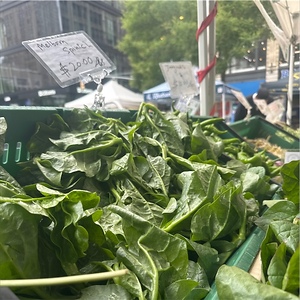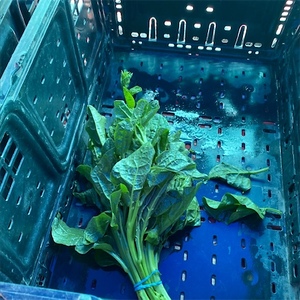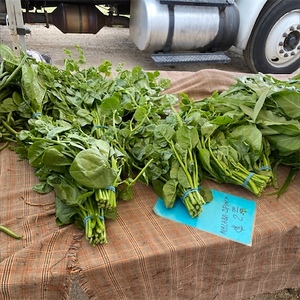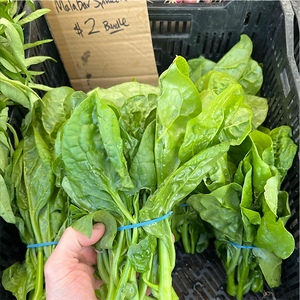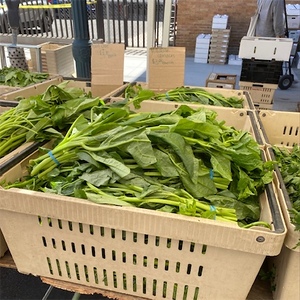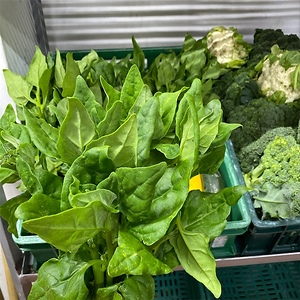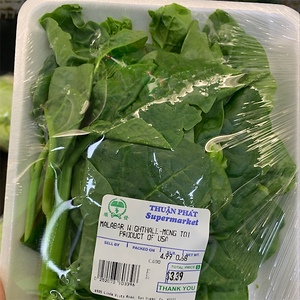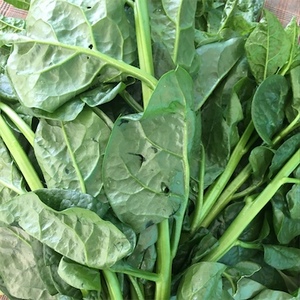

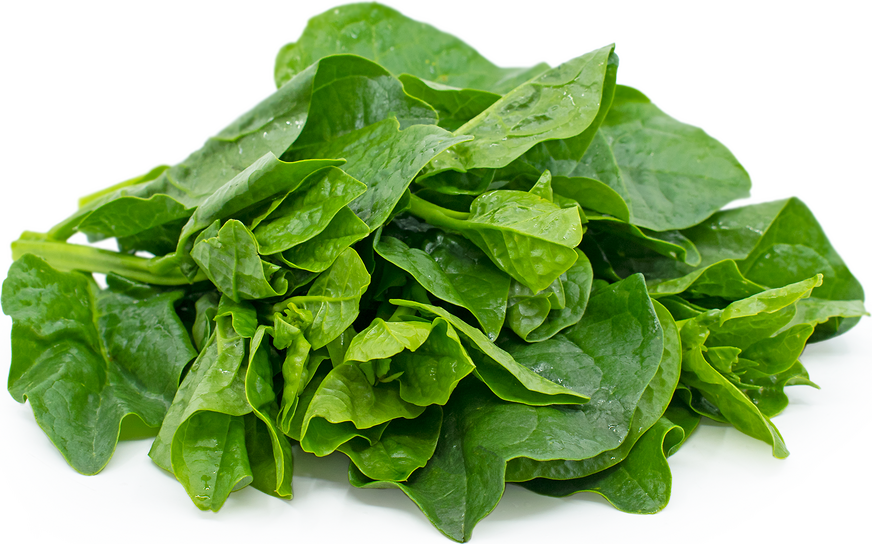
Malabar Spinach
Estimated Inventory, bunch : 0
Description/Taste
Green Malabar spinach is comprised of small to medium-sized leaves, averaging 5 to 10 centimeters in length, and has a broad, oval, to cordate shape tapering to a blunt or pointed tip. The leaves have a wavy, crinkled appearance and showcase prominent veining across the dark green, glossy surface. Green Malabar spinach is distinct for its thick, slightly stiff, and sturdy nature, and when consumed raw, the leaves have a succulent, crunchy, chewy, and mucilaginous consistency. The leaves grow alternately along bright green, cylindrical stems, and the stems are pliable with a fleshy, crisp texture. Green Malabar spinach leaves and stems can be eaten when young and tender, or they can be consumed in their mature state. The greens have a mild, fresh, vegetal, and earthy flavor with subtle nuances of pepper and citrus. In the fall , Green Malabar spinach produces tiny white to pink-white flowers in specific climates, followed by clusters of seasonal round berries about the size of a pea. The berries have a dark purple, glossy surface and are edible but have a bland, neutral flavor.
Seasons/Availability
Green Malabar spinach is available year-round in tropical climates. In subtropical to temperate climates, the greens have a peak season in the summer through fall.
Current Facts
Green Malabar spinach, botanically classified as Basella alba, is an evergreen tropical vine belonging to the Basellaceae family. The climbing perennial is native to Asia, named after a coastal region in southwestern India, and has been naturalized in warm climates worldwide, sometimes being grown as an annual in milder areas. Despite its spinach moniker, Green Malabar spinach is not a true spinach and is a much hardier plant, producing thick, succulent leaves that can be used raw or cooked. There are two types of Malabar spinach, one with green leaves and stems, known as Basella alba, and one with red stems and green leaves, classified as Basella rubra. Green Malabar spinach is not commercially cultivated and is primarily grown as a specialty home garden for culinary and ornamental uses. The vines naturally climb over fences, walls, and posts and typically extend 1.8 meters in length, sometimes reaching over 10 meters. Growers favor Green Malabar spinach for its vigorous, fast-growing nature, maturing in 70 to 85 days, and continuous harvest. The leaves are also heat tolerant, thriving in warm summer conditions where ordinary spinach would not typically survive. Throughout Asia, Green Malabar spinach is known by many different regional names, including Ceylon spinach, Indian spinach, Huang Gong Cai and Muer Cai in China, Malabar Kirai in Tamil, Malabar Baccalikura in Telugu, Alugbati in the Philippines, Mong Toi in Vietnam, Di Huang Miao in Singapore, Remayong in Malaysia, Paag Prang in Thailand, and Jingga or Gendolak in Indonesia.
Nutritional Value
Green Malabar spinach is a source of vitamin C to strengthen the immune system while reducing inflammation, fiber to regulate the digestive tract, and vitamin A to maintain healthy organ functioning. The greens also provide iron to develop the protein hemoglobin for oxygen transport through the bloodstream, potassium to balance fluid levels within the body, calcium to build strong bones and teeth, antioxidants to protect the cells against free radical damage, and other nutrients, including manganese, folate, phosphorus, and magnesium. In natural medicines, Green Malabar spinach is used for its mucilaginous properties as a healing topical when crushed and smoothed over sores, rashes, and irritations. The leave's juice is also placed in the nose and throat to reduce inflammation in Nepal.
Applications
Green Malabar spinach has an earthy, peppery, and subtly citrusy taste suited for fresh and cooked preparations. The leaves have a thicker consistency, creating a crisp and succulent nature when added to salads, as a bed of greens, or layered in sandwiches. Green Malabar spinach can be eaten when it is young and tender or consumed at maturity. In addition to fresh preparations, Green Malabar spinach is popularly cooked, creating a dense, chewy, and slippery texture. The greens are used as a spinach substitute and won't wilt as fast in heat, making them favored for boiled and sauteed dishes. Green Malabar spinach can be sauteed with other vegetables, boiled and served with meats, dipped in batter and fried, or used as a thickening agent in curries, soups, and stews. In India, Green Malabar spinach is commonly added to seafood dishes, curries, soups, stews, dal, or cooked into porridge. Green Malabar spinach is also boiled with vegetables and fish in a dish known as utan in the Philippines. Green Malabar spinach pairs well with flavoring agents such as soy sauce, sesame, garlic, onions, and shallots, bell peppers, broccoli, chile peppers, spices including cardamom, cinnamon, curry, and cumin, and seafood such as white fish, shrimp, scallops, and squid. Whole, unwashed Green Malabar spinach should be immediately used for the best quality and flavor and will keep for 2 to 5 days when stored in the refrigerator. The greens can also be parboiled and frozen for 9 to 14 months or dried and ground into a powder for extended use.
Ethnic/Cultural Info
Green Malabar spinach is famously incorporated into dal recipes in India. Dal is derived from Sanskrit, meaning "to split," and is a term used to encompass ingredients and dishes that, at the core, are a thick mixture of cooked lentils, peas, or beans, creating a creamy, puree-like consistency. The dish's roots can be traced to the Indus Valley Civilization, spanning from 3300 to 1300 BCE. Lentils were a staple culinary ingredient during this time, and they continued to be one of the central foods throughout medieval India. Some historians recount that slow-cooking lentils in steam was one of the most popular cooking methods, and serving any other type of dal besides chana dal, also known as Bengal gram lentils, to the emperor was considered taboo. In the present day, dals are regionally specific throughout India, and in southern India, the creamy dishes are often mixed with leafy greens as a nutritional enhancement. Green Malabar spinach is common throughout southern India, and the leaves are traditionally harvested from backyard or nearby wild plants and simmered into the dal as a thickener. The dish is seen as comfort food and is typically served with hot rice.
Geography/History
Green Malabar spinach is native to Asia and has been growing wild since ancient times. Much of the plant’s history is unknown, but experts believe the variety may have originated in India and parts of Southeast Asia. Green Malabar spinach was spread into Africa and East Asia in the early ages through trade routes, and over time, the species became embedded into culinary dishes as an everyday green. The variety also escaped cultivation and naturalized, becoming somewhat of an invasive species in some regions. Green Malabar spinach thrives in hot, moist, and humid regions and is found wild in lowlands, forests, along streams, and near cultivated land. The species eventually reached Europe, North America, and South America through migrating peoples, and the first mention of Malabar spinach in English written texts was documented in 1691. Today Green Malabar spinach is primarily foraged from wild plants or sown in home gardens and is grown as a medicinal and culinary crop worldwide. The species is found in tropical to subtropical climates in Asia, Oceania, tropical Africa, North America, the Caribbean, Central and South America, and Europe. Fresh Green Malabar spinach is sold through local markets, specialty retailers, and direct from farms and home gardens.
Recipe Ideas
Recipes that include Malabar Spinach. One



